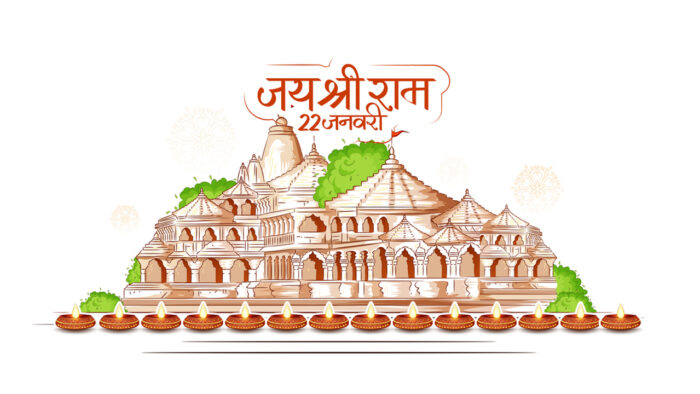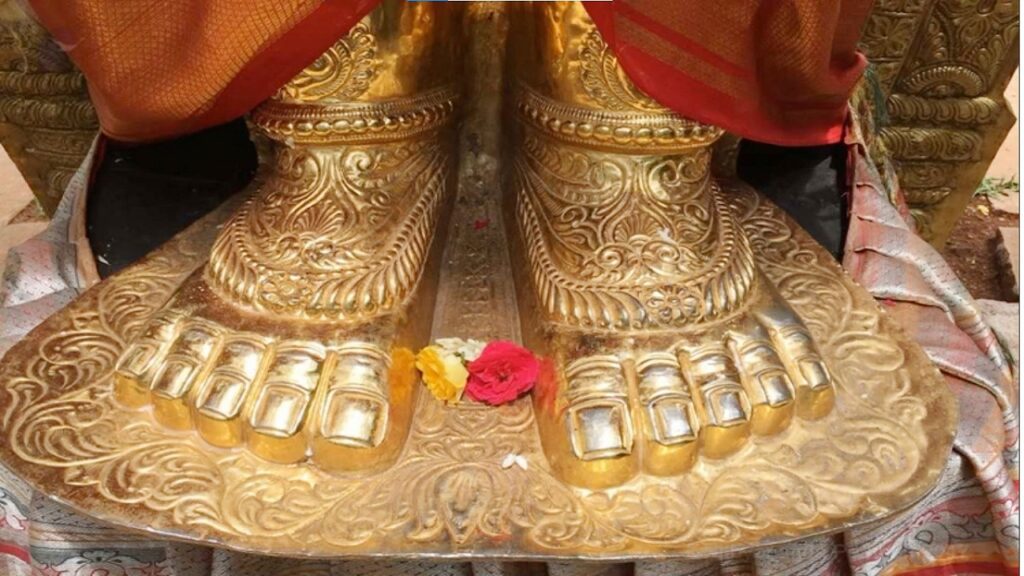As we stand on the brink of the historic consecration of Rama Mandiram in Ayodhya on January 22, 2024, this becomes a momentous occasion for all Bharatiyas. Amidst this jubilant atmosphere, there is no better subject to delve into than the Lord’s Paduka (Sandals), which gracefully ruled Ayodhya/Saketa for 14 years during Lord Rama’s exile.Bharata, with deep reverence, carried her over his head, conducting daily worship for her.
In the tapestry of this celebration, Swami Vedanta Desika, the venerable Srivaishnavite Acharya, poet, and logician, wove a thousand-versed hymn dedicated to the Paduka. This magnificent ode was meticulously crafted in a single night, showcasing the Acharya’s profound devotion. The challenge that led to this composition was initiated by a Srivaishnavite scholar, challenging Swami Desika to compose a thousand verses in one night, focusing on Lord Ranganatha, the ancestral God of the Raghus. Despite Swami Desika’s initial reluctance towards such challenges, he took this as an order from the Lord, leading him to effortlessly triumph in the challenge, worshipping her as Paduka Devi.
The Lord’s Paduka is none other than Swamy Nammazhwar, also known as Satakopawho is one among the twelve Azhwars in the Srivaishnava tradition. He is also the only Azhwar who falls under the Acharya category as well.
Paduka Sahasram, as the name suggests, is a 1000-versed hymn comprising 32 padhdhatis (chapters). One such padhdhati is the ‘Chitra Padhdhati,’ where Swami Desika, in his role as a poet, vividly appears in action, crafting verses in padmabanda, ekakshari, dvyakshari, and more.As an Acharya Stuti, the recitation of Paduka Sahasram bestows health, wealth, and prosperity upon those who engage with it.
In the first chapter of Paduka Sahasram, Swami Desika expresses his apprehension about attempting to eulogize the divine Paduka—a feat not even ventured by the revered Vedas. Even these repositories of knowledge seem to admit the impossibility of capturing the essence of the Lord’s Paduka within their extensive teachings. Undaunted, Swami fearlessly embarks on this literary odyssey, acknowledging the audacity of his endeavor. He understands that his clumsy efforts to praise what the Vedas have left untouched might amuse Lord Ranganatha and provoke his laughter. Yet, Swami interprets this amusement as a service to the Lord, as humor (hasya) is also a sentiment (rasa), ensuring that his attempts to extol the glory of the Paduka do not go in vain. This narrative unfolds the profound magnificence of the Paduka and showcases Swami Desikan’s humility.
अनिदं प्रथमस्य शब्दराशेरपदं रङ्गधुरीणपादुके! त्वाम्।
गतभीतिरभिष्टुवन् विमोहात् परिहासेन विनोदयामि नाथम्।।१॰१६
anidaṃ prathamasya śabdarāśerapadaṃ raṅgadhurīṇapāduke! tvām।
gatabhītirabhiṣṭuvan vimohāt parihāsena vinodayāmi nātham।।1॰16
(Meaning – O Ranganatha’s Paduka! You are indescribable, even for the blemishless Vedas. Yet, here I am, fearlessly attempting to eulogize you, thereby becoming a source of amusement for the Lord. But that’s fine, as making the Lord smile is also considered a service.)
In the eighth Padhdhati, named “niryātana-padhdhati,” Swami unfolds a tale of how Paduka Devi safeguards her subjects from the Lord’s righteous wrath. This story originates from the moment when Lord Rama aimed the Agneya-astram at Samudra-Raja (the Ocean), yet the ocean defiantly resisted its impact. Swamy ponders the mystery of how the Lord’s arrows failed to affect Samudraraja and comes up with a solution imbued with poetic brilliance. During the grandeur of the Paduka-pattabhisheka (coronation of the Paduka), the sacred waters from the Paduka flow into the Tamasa and Sarayu rivers, eventually merging with the vast ocean. Now purified by the coronation waters, the ocean is enveloped in the divine aura of the Paduka Devi. Consequently, Rama’s arrows prove ineffective against Samudraraja, who seeks refuge in the protective embrace of the Paduka. The underlying message conveys that with the Acharya’s blessings, a shield is raised against the Lord’s formidable wrath, as our Lord venerates both Daya and the Paduka.
सम्भिद्यमानतमसासरयूपनीतैः संवर्धितस्तव शुभैरभिषेकतोयैः ।
मन्ये बभूव जलधि: मणिपादरक्षे रामास्त्रपावकशिखाभिरशोषणीयः।। ८॰९
sambhidyamānatamasāsarayūpanītaiḥ saṃvardhitastava śubhairabhiṣekatoyaiḥ ।
manye babhūva jaladhi: maṇipādarakṣe rāmāstrapāvakaśikhābhiraśoṣaṇīyaḥ।। 8॰9
In the thirtieth chapter titled Chitra-Padhdhati, Swamy beautifully crafts a verse that intricately lists all the declensions of the letter ‘A’, forming a Shabda-chitra. The letter ‘A’ symbolizes Lord Vishnu, and Swami deftly employs the seven case declensions, showcasing his poetic brilliance and mastery over the language. For a first-time reader, deciphering the words in this verse might seem daunting. The seven case declensions for the letter ‘A’ in singular form are – अः, अम्, एन, आय, आत्, अस्य, ए (aH, am, ena, Aya, At, asya, e). Poems like these are meant to be savored for their sheer brilliance.
यामः श्रयति यां धत्ते यैन यात्याय याच्च या ।
यास्य मानाय यै वान्या सा मामवतु पादुका ।। ३०॰७
yāmaḥ śrayati yāṃ dhatte yaina yātyāya yācca yā ।
yāsya mānāya yai vānyā sā māmavatu pādukā ।। 30॰7
Word Split –याम् अः श्रयति, या अं धत्ते, या एन याति, आय या, आत् च या, या अस्य मानाय, या ए वान्या, सा माम् अवतु पादुका।
(yām aḥ śrayati, yā aṃ dhatte, yā ena yāti, āya yā, āt ca yā, yā asya mānāya, yā e vānyā, sā mām avatu pādukā)
(Meaning – May the Paduka that is – adorned by the Lord, carries the Lord, travels exclusively with the Lord, originates from the Lord, intended for the Lord’s honor, and accessible through the Lord protect me.)
In the thirty-first Padhdhati, named “nirveda-padhdhati,” Swami implores Paduka Devi that after complete surrender, any inauspiciousness faced by him would tarnish the renowned reputation of Lord Rama’s Paduka as a savior. This is expressed rhetorically, emphasizing the belief that those who surrender at the feet of Lord Rama are shielded from any inauspiciousness, aligning with the sentiment, “न वासुदेव भक्तानामशुभं विद्यते क्वचित्” (na vāsudeva bhaktānāmaśubhaṃ vidyate kvacit).
मातस्त्वदर्पितभरस्यमुकुन्दपादेभद्रेतराणियदिनामभवन्तिभूयः।
कीर्तिःप्रपन्नपरिरक्षणदीक्षितायाःकिंनत्रपेततवकाञ्चनपादरक्षे।।३९॰८
mātastvadarpitabharasyamukundapādebhadretarāṇiyadināmabhavantibhūyaḥ।
kīrtiḥprapannaparirakṣaṇadīkṣitāyāḥkiṃnatrapetatavakāñcanapādarakṣe।।39॰8
(Figure 1: credit: youtube – Rama’s Paduka)
In conclusion, comprehending the greatness of Paduka Sahasram and grasping the profound meaning it imparts requires a lifetime. In essence, Paduka Sahasram stands as a timeless testament to devotion, literary brilliance, and spiritual profundity. As we approach the momentous consecration of Rama Mandiram in Ayodhya, the resonance of Swami Vedanta Desika’s hymn dedicated to the Paduka becomes even more poignant. I extend an invitation to all readers to explore the verses of Paduka Sahasram, to savor the poetic beauty, and to contemplate the timeless wisdom it imparts. May your exploration be as enriching and transformative as the verses themselves.
Disclaimer: The opinions expressed in this article belong to the author. Indic Today is neither responsible nor liable for the accuracy, completeness, suitability, or validity of any information in the article.










